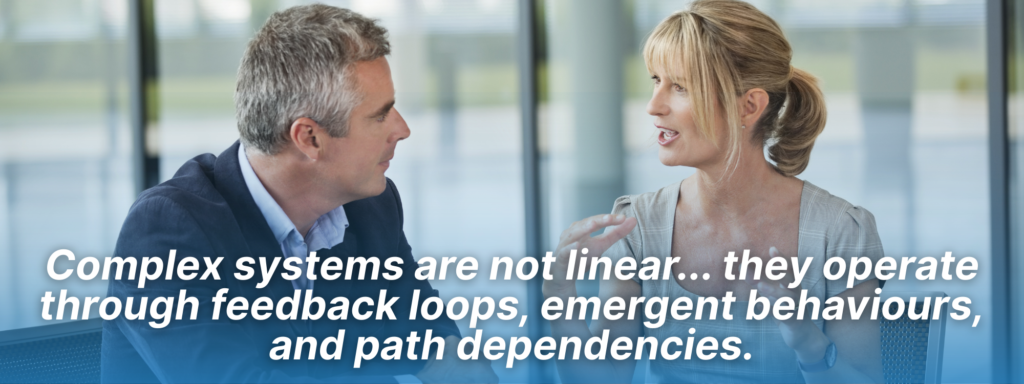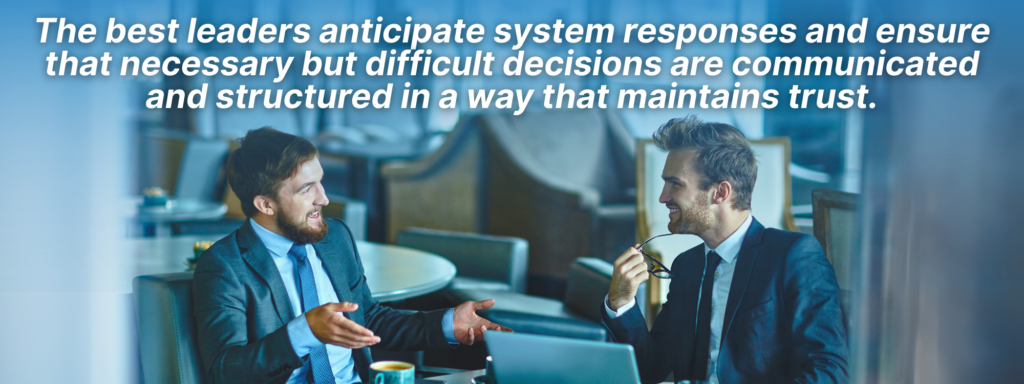Balancing Dilemma
Leadership is not a matter of ticking boxes or following formulas—it is the art of steering through shifting, high-stakes terrain where every decision sends ripples through an unpredictable system. A leader can make the most rational choice and still trigger resistance, upheaval, or institutional paralysis. In today’s volatile world, where perception shapes reality, fairness is not optional—it is the currency of trust. Without it, fragmentation is inevitable, and leadership collapses into firefighting rather than forward motion.
Leaders who over-rely on objectivity risk alienating stakeholders. However, in crisis management or rapid market shifts, top-down decisiveness is sometimes necessary to maintain stability and momentum. When objectivity is imposed without fairness, it can trigger distrust and destabilise organisations.
Those who over-prioritise perceived fairness risk decision paralysis, allowing competitors and market conditions to dictate their fate. The challenge is not simply balancing fairness and objectivity—it is integrating them to ensure that strategic decisions are trusted, adaptive, and executable.
Consider the case of Microsoft under Satya Nadella, where integrating fairness into strategy enabled a seamless transformation. We explore this in more depth later. This essay explores how leaders can integrate fairness and objectivity within social systems, ensuring decisions are not only strategically sound but also trusted, adaptive, and executable in an unpredictable world.

Adversarial Framing
A key challenge in social systems is the illusion of balance—the belief that presenting two opposing views equally ensures fairness. In reality, false balance can amplify division rather than fostering understanding. However, complex systems are not linear—decisions do not yield predictable, proportional outcomes. Instead, they operate through feedback loops, emergent behaviours, and path dependencies.
Julian Baggini critiques adversarial framing in media debates, such as the controversy around the play Behzti. The BBC’s Today Programme presented it as a binary clash—secular free speech versus religious protest—rather than exploring shared values and adaptive solutions. This created a distorted picture of reality, amplifying divisions while ignoring the nuanced middle ground, where many likely agreed on both artistic freedom and cultural sensitivity. A social systems-informed approach would have uncovered shared values and fostered adaptive solutions rather than reinforcing entrenched positions.
Leaders often structure debates as “growth vs. stability,” “profit vs. ethics,” or “innovation vs. tradition,” reducing complex challenges to false dichotomies. Toyota’s Lean Manufacturing model demonstrates that the most effective decisions integrate multiple perspectives rather than forcing an either-or choice.
Leadership Lesson: In social systems, binary framing is not balance—it is a mechanism that artificially hardens opposition. Leaders must curate debates to encourage synthesis, not conflict.

Fairness as a Stabiliser
Social systems thrive on trust, alignment, and adaptability. If leaders ignore the fast-thinking perception of fairness, their decisions—however rational—risk destabilising the system.
Fairness in leadership functions much like predator-prey dynamics in an ecosystem. At first glance, the presence of predators may seem purely destructive, much like top-down authority in an organisation.
However, in a well-balanced system, predators prevent overpopulation, maintain biodiversity, and ensure long-term ecosystem stability. In the same way, fairness in leadership is not about eliminating authority—it’s about structuring it so that trust is maintained even when difficult decisions must be made.
Leaders who enforce decisions without fairness are like invasive species—disrupting equilibrium and triggering unforeseen collapses. By contrast, leaders who integrate fairness act as keystone species, shaping environments where adaptation, growth, and resilience become systemic rather than imposed.
Right & Wrong Rightsizing
Toyota’s Kaizen culture demonstrates how perceived fairness acts as a stabilising force. A similar principle applies in education, where universities that implement transparent tenure review processes create a sense of stability and trust among faculty members, ensuring that even those who do not receive tenure perceive the system as fair and merit-based.
When closing factories, Toyota engages employees early, provides reskilling opportunities, and ensures transparent transition planning. In contrast, General Motors’ abrupt layoffs in the 2000s—announced without structured engagement—triggered union revolts, reputational damage, and workforce disengagement. Toyota’s fair process approach ensured that difficult transitions did not spiral into organisational breakdowns.
Similarly, in public discourse, the false equivalence of vaccine debates in the early 2000s created destabilising effects. By giving equal weight to a fringe anti-vaccine claim and the overwhelming scientific consensus, media framing amplified public distrust, making future public health messaging significantly harder.
Leadership Lesson: In social systems, fairness is not just ethical—it is a structural necessity. Perceived fairness stabilises adaptation, ensuring that organisations and societies can absorb necessary changes without cascading resistance.
Just as fairness stabilises systems, its absence can accelerate fragmentation. When fairness is ignored, decisions—no matter how rational—become rallying points for resistance, creating self-reinforcing cycles of distrust.

No Fairness is Destabilising
In social systems, leaders who impose top-down, purely objective decisions without considering how they are perceived risk triggering self-reinforcing resistance loops.
Netflix embraces radical objectivity but tempers it with a structured fairness framework. Employees expect high turnover because the rules are transparent, performance reviews are structured, and expectations are clear from the outset. This prevents large-scale backlash and ensures that objectivity is perceived as fair.
Contrast this with Apple’s shift of manufacturing to China, which was economically rational but lacked perceived fairness for U.S. workers. Without early communication or structured transition strategies, the move generated political backlash, reputational damage, and resistance from policymakers and employees.
Leadership Lesson: Objectivity must be framed within a fair process. The best leaders anticipate system responses and ensure that necessary but difficult decisions are communicated and structured in a way that maintains trust.
Fair Process Leadership
Fair Process Leadership is not just a communication technique—it is a complexity-handling mechanism that enables adaptation without chaos. Leaders can implement it using structured engagement methods such as stakeholder listening sessions, transparent decision rationales, and iterative feedback loops. To absorb change without destabilisation, leaders must first establish clear rules of engagement.
Setting expectations early and providing structured pathways for adaptation ensures that employees remain aligned, even when facing uncertainty. When decisions are framed within a participatory process, employees and stakeholders are more likely to accept outcomes even if they do not align with their individual preferences.
Rather than imposing cloud-first strategies unilaterally, Microsoft’s CEO, Satya Nadella, used Fair Process Leadership:
- He engaged early by framing the transition not as a battle between legacy and innovation, but as an evolution of Microsoft’s mission.
- He provided a clear explanation, so employees understood why the shift was necessary.
- He established clear expectations, offering structured pathways for employees to adapt rather than resist.
This social systems approach ensured that Microsoft’s transition was absorbed systemically, rather than triggering fragmentation.
Fair Process Leadership does not mean consensus-based decision-making; it ensures engagement without requiring universal agreement. Unlike pure consensus models, it provides structured transparency, enabling even those who disagree to trust the process.
Similarly, in governance, Sweden’s COVID-19 response demonstrated how fair process leadership can manifest in a decentralised, trust-based model. However, in more hierarchical or collectivist cultures, such as Japan or South Korea, fair process leadership often incorporates structured consensus-building, ensuring that decisions reflect group harmony and long-term stability.
This variation highlights how cultural context shapes perceptions of fairness and leadership effectiveness. Sweden’s decentralised, trust-based model allowed for adaptation without the societal disruptions seen in countries where strict mandates provoked widespread noncompliance. By contrast, in more rigidly controlled environments, enforcement often led to instability rather than alignment.
However, Sweden’s approach was also criticised for its higher initial death rates and economic trade-offs. This highlights an important principle: fair process leadership does not guarantee universally positive outcomes, but it creates the conditions for long-term social adaptability.
Leadership Lesson: Social systems demand continuous alignment, transparency, and flexibility. Leaders who structure fair processes ensure that adaptive change is implemented rather than resisted.
Final Thoughts
In a world governed by complexity, the illusion of balance is a dangerous trap. Leaders must not simply aim to appear fair or rely on cold objectivity; they must curate decision-making environments that foster adaptive alignment.
In complex systems, leadership is not about appearing fair or enforcing objectivity—it is about structuring environments where trust enables action. The best leaders do not just make decisions; they ensure the system can carry them forward. The question is not whether your choices are correct, but whether they are trusted enough to be executed without resistance.
The challenge is not just about managing conflict or appearing fair but about structuring leadership in a way that sustains momentum without fragmentation. The lessons below provide a blueprint for achieving that delicate balance:
- Abandon adversarial framing—polarisation is a leadership failure, not a necessity.
- Embed fairness as a system stabiliser—trust is not a sentiment but a core feature of adaptive systems.
- Ensure objectivity is perceived as fair—decisions must be both correct and trusted.
- Use Fair Process Leadership—successful adaptation requires structured engagement, transparent reasoning, and clear expectations.
Leadership in complexity is not about being ‘right’; it’s about creating conditions where people trust the process—even when they disagree with the outcome. The real test of leadership is not making decisions—it’s ensuring they are trusted, absorbed, and acted upon.
Are you leading in a way that builds alignment, or are you merely issuing directives?



